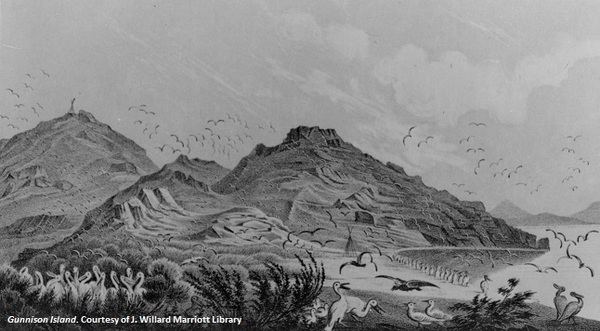Dublin Core
Title
Description
Wings flashing in the sunlight, raucous calls filling the air, and tons of bird excrement coating the rocks. Learn about guano gathering out on the Great Salt Lake.
Making a living collecting bird droppings does not exactly sound like the ideal job. But from the mid-1890s until the turn of the century, guano mining existed in Utah. Gunnison Island – located out in the Great Salt Lake – is only a mile long. Yet it is the nesting ground for huge populations of gulls, pelicans, and herons. Its rocks provide an excellent home for infant birds and the surrounding waters protect them from predators. Nearby, Hat Island – which is even smaller – serves the same purpose. And where there are birds, there is bird waste.
For centuries, the bird rookeries of Gunnison and Hat Islands produced deep layers of guano. This bird excrement is rich in phosphate and nitrate, and therefore useful as fertilizer. Commercial guano miners first came to Gunnison Island in the mid-1890s and got straight to work. With pick and shovel, some dug up the guano deposits, while others worked at the sieves. Enveloped in clouds of brownish dust, they passed the mineral through screens and into bags. Trenches and pits soon covered the small island, as the workers extracted ancient deposits.
Utah artist Alfred Lambourne had been living alone on Gunnison Island, until the guano miners showed up in the spring of 1896. He wrote that the island’s solitude was transformed into frantic activity, causing the pelicans to search elsewhere for nesting sites, but leaving the gulls to scream constantly at the invaders. Lambourne was fascinated by the workers, noting their habits and various nationalities. The crew had traveled the world harvesting guano in places as distant as Brazil and the Mediterranean Sea. By early winter, the miners were done for the season and a schooner came to retrieve them and their diggings.
But the guano business did not fly. While the guano was easy to access, it was difficult to harvest. And mining it polluted the lake. Once the guano gatherers finally left the islands, the birds returned to nest – and to raise their young in raucous peace.
Creator
Source
_______________
See Lyndia Carter, “Guano Sifters of Gunnison Island,” History Blazer, Utah State Historical Society, June 1996,http://www.historytogo.utah.gov; Alfred Lambourne, “Our Inland Sea: The Story of a Homestead,” Deseret News, 1909; George E. Blair and R. W. Sloan, eds., The Mountain Empire: Utah, (Salt Lake City, 1904), pp.72-73; Dale Morgan, The Great Salt Lake (New York: MacMillan Publishing Co., 1947), pp. 375-76.

